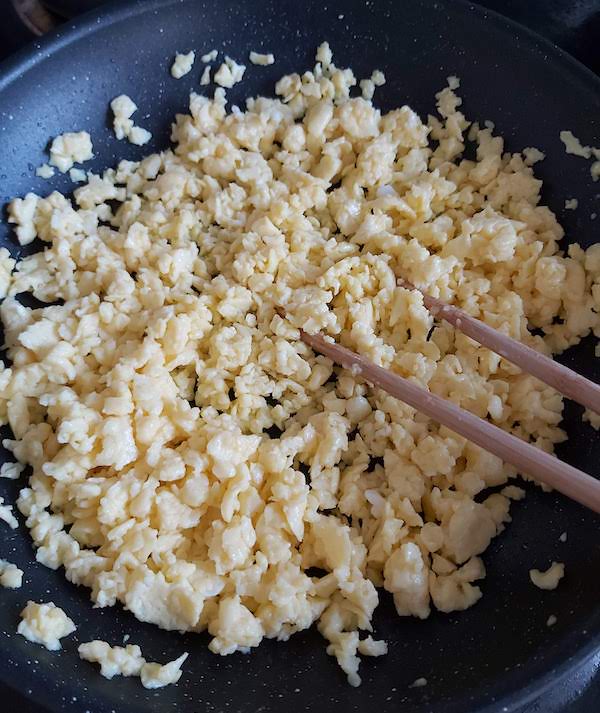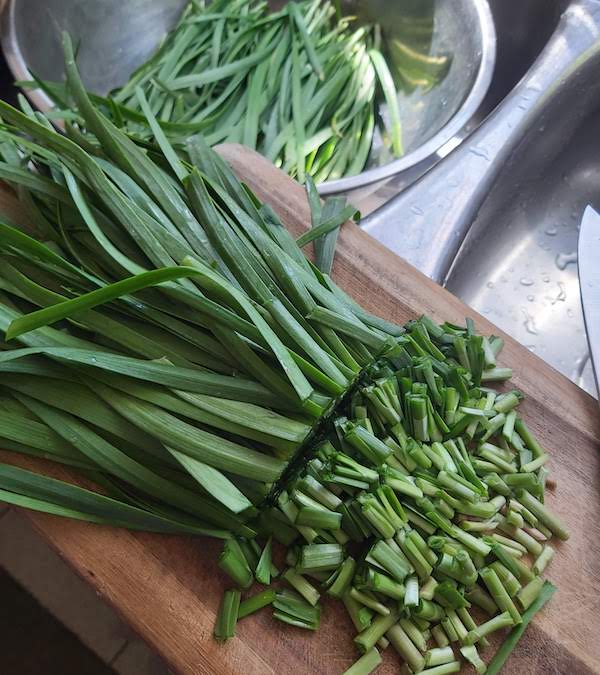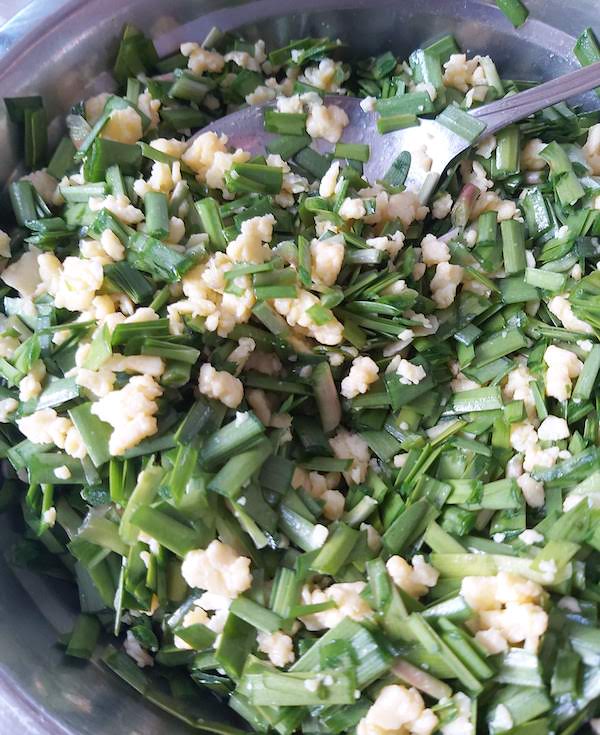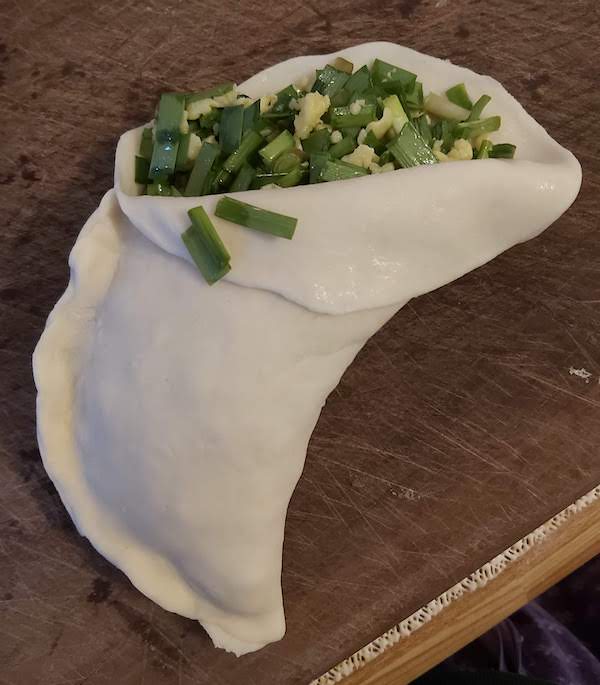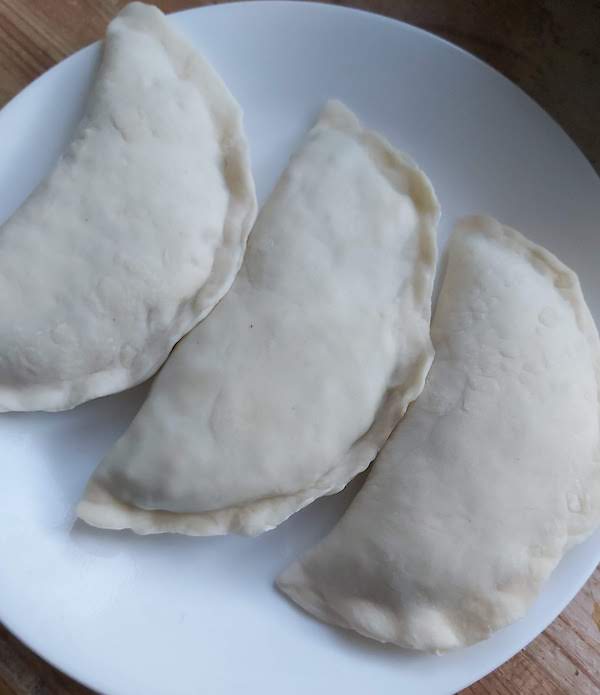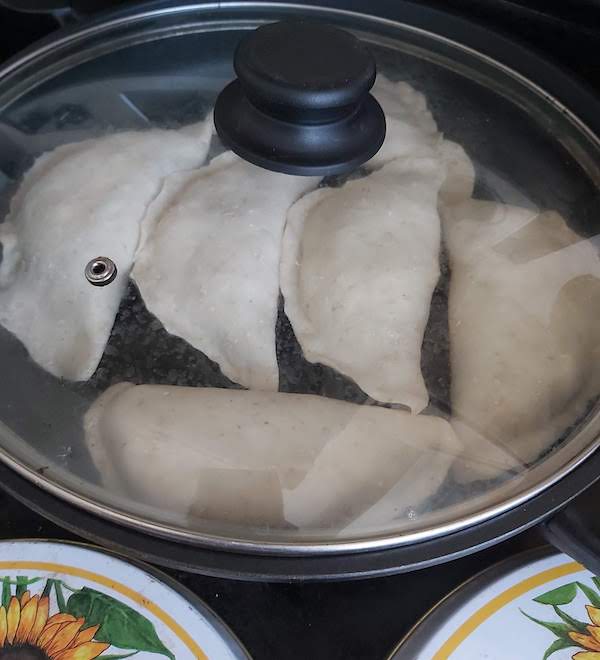The Wrapping:
A three to one ratio of flour to water kneaded into dough that can be used for jiucaihezi, dumplings, and even noodles. A combination that brings back memories of learning your culture, your mother transmitting it to you with each knead, each spoonful of filling, each crimp, with the reminder to be careful to squeeze until the two halves of the wrapping have been combined into one.
The Filling:
Eggs
Cook these first, fittingly, this versatile food was the first thing you learned how to cook. It gave you a sense of pride at 11 that you could do this for yourself, that you were started on the journey of knowing how to care for yourself, fend for yourself. You’d make them when the adults were taking too long to get home, you’d make them because you love scrambled eggs, you’d continue to make them even away from home, off at university, on exam days hearing the echo of your mom slipping you an egg before your high school exams because they were brain food, and now they feel something like good luck. Eggs were the one thing you knew you could always get right, even with mishaps of burnt food and, once a countertop, in the process of learning how to cook.
The cooking method for the filling of jiucaihezi is slightly different from how you’d usually make them, though. You need to scramble the eggs well, then in a pan, pour more oil than you’d normally use and pour the eggs in right away, the stove on low heat. Next, using chopsticks or another tool you need to start stirring so when the eggs start cooking, it’s all broken down into small pieces, the filling won’t taste good if the chunks of egg are too big. At first it always feels pointless and long because these eggs are clearly not going to solidify any time soon, but then you hit the tipping point and you’re glad that you were there all along because thanks to it, you’re able to move fast and continue moving fast and you end up with eggs that are cooked and in small pieces, the smaller the better. Finally, add more salt than you normally would because you don’t salt or add oil to the chives.
The chives
While the eggs are cooling, pick out your chives wash them thoroughly and set them to dry, drier is better so your jiucaihezi doesn’t squirt out broth everywhere when you bite into it. But sometimes that’s part of the fun, the warm “soup” dribbling down your chin and through your fingers.
Cut the chives into small pieces about a centimeter long or so and think about those summer days tending them in the garden. How they come back, generously offering you nourishment year after year, how their leafy green shoots always signal the beginning of spring and bring with it a sense that “this plant is an old friend” loyal, kind. How so many things have changed in your life over the years but one thing you can always count on is the chives and how they live with you in reciprocity.
When the eggs are cool combine the two, the proportion is really up to you, but usually aiming for what you eyeball as “half and half” is tasty.
Take a chunk of your dough, use a rolling pin to flatten it into a round wrapper, get it as thin as you can make it before your arm gets too tired (don’t worry, usually your arm will get tired before you get even close to making it too thin, or thin enough to break). Keep the center a little fatter than the edges so the middle doesn’t break, remember you were taught to do this first from those early days learning to make dumplings, but this same rule holds for jiucaihezi and baozi too. Again, the size is really up to you, you can make dumpling sized ones or ones as big as half a small plate. You grew up with the half plate sized ones so there is something nostalgic about making bigger jiucaihezi.
Put some filling into your wrapper, enough to really stuff it when you fold it and crimp it into a half moon.
When you’ve folded a few it’s time to cook, take out a non-stick pan and a lid that can cover the pan. You can add a little oil but I prefer not to. Using medium-low heat put your doughy half moons in the pan and cover it with the lid. Keep an eye on them and flip it over when you see that the side touching the pan is a golden-brown colour ~ 5 minutes depending on the stovetop. Flip it over and cook the other side, again covering the pan with a lid and looking for that golden brown colour, about 2-3 min again depending on the stovetop. When all the dough looks cooked, your jiucaihezi is ready to eat, be sure to be extra careful of that middle section, the straight side of the half moon, that never touches the pan.
Take out your finished jiucaihezi and enjoy. Think about how this food was always a favourite growing up and also has another layer of special meaning now because this was the first “complicated and delicious” cultural food that you were able to make all on your own that summer after first year when you were alone in the house. It represents your successes as a cook, in caring for yourself, and the way your culture lives on within you, as a Chinese person whose identity is hyphenated with Canadian.
This is why food means so, so much to us racialized folks.
***
Author’s Note:
I wrote this piece inspired by a format my friend Joelle Kidd used in her piece in Living Hyphen, a magazine for Canadians with hyphenated identities, wanting to capture all the things this food meant to me after making Jiucaihezi (direct translation to English from Mandarin is “chive boxes” jiucai = chives, hezi = boxes) with chives from the garden this spring. I wanted to write it out in this format because food means so much to Chinese people, racialized people in general, and also this specific food means a lot to me personally and you can’t illustrate that with a plain recipe. You should be able to make jiucaihezi following this as a guide, and I also want to note that you can pretty easily make a vegan version by swapping out the eggs with scrambled tofu, though I recognize it doesn’t have a lot of precise measurements (sorry this is just how Asian cooking goes, I wish you luck with experimenting and may the voices of your ancestors whisper “that’s enough child” at the appropriate time XD).

